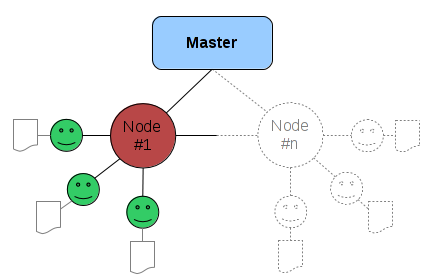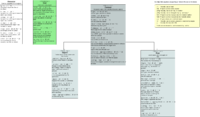Difference between revisions of "Platform Team/Sugar Network/Architecture"
m |
|||
| (3 intermediate revisions by the same user not shown) | |||
| Line 84: | Line 84: | ||
* Private data in user's home directory, | * Private data in user's home directory, | ||
* Data accessible from removable devices like USB sticks or SD cards. | * Data accessible from removable devices like USB sticks or SD cards. | ||
| − | |||
| − | |||
| − | |||
| − | |||
== Synchronization == | == Synchronization == | ||
| Line 97: | Line 93: | ||
* With the Master, if connectivity presents; | * With the Master, if connectivity presents; | ||
* With the Master or any other Node servers via the [[Wikipedia:Sneakernet|Sneakernet]]. | * With the Master or any other Node servers via the [[Wikipedia:Sneakernet|Sneakernet]]. | ||
| − | |||
| − | |||
| − | |||
| − | |||
| − | |||
| − | |||
| − | |||
| − | |||
| − | |||
| − | |||
| − | |||
| − | |||
| − | |||
| − | |||
| − | |||
| − | |||
| − | |||
| − | |||
| − | |||
| − | |||
| − | |||
| − | |||
| − | |||
== Getting involved == | == Getting involved == | ||
Latest revision as of 22:42, 26 November 2012
This is a twin page of Sugar Network's basic concepts from technical point of view. See also the introduction page.
Overview
Functioning
The only worfklow within the Sugar Network from the technical point of view is:
- Clients create, modify and browse different types of resources (resources from conceptual point of view, resources from the API point of view) on a server;
- If this server is a Node server, the system will take care about synchronizing its resources with other Node servers and, finally, with the central one, the Master server.
Components
This is technical view on three levels of the Sugar Network:
Server
Server side is represented by:
- Master server that keeps the whole Sugar Network information, clients might connect directly to this server (on-line case) or indirectly via Node servers (off-line case);
- Optional Node servers, contain a synchronised copy of central server (might be not for the entire Network to save storage space);
In all cases the server API is the same for clients. But depending on connectivity, clients might be connected to the Master server or to a intermediate server.
Master server
The place where data is being collected from all Node servers. If clients have connectivity, they can connect to the Master to contribute to the Network directly.
Node servers
Servers that will be useful if:
- there is no connectivity at all;
- connectivity is sporadic;
- connectivity is not cheap and its usage needs to be minimized.
Node servers provide full featured API as the Master does. Nodes need to be synchronized.
Conceptual level
This is how Sugar Network looks like on conceptual level represented by the API.
Objects model
The following diagram shows the full list of objects implemented by the Sugar Network API.
Property types
Generally, Sugar Network objects' property types correspond to JSON types. The only exceptions mentioned in the following list:
- enum, is an enumerated type when a value is a string from the predefined list of constants;
- markdown, is a string formatted in the Markdown syntax;
- blob, is a file represented by string value which is a SHA-1 digest of file's content; the file itself can be obtained from the
GET /blobs/DIGESTrequest; - aggregated, is a list of JSON objects which has special API to treat its items; each aggregated item has a unique identifier; items might be created not only by the object's authors.
Resource.author
A dictionary of authors working on the corresponding resource. Keys are Sugar Network User guids, or, if particular author is not registered in the Sugar Network, full user names. Values are dictionaries with the following keys:
- name
Full author's name; - role
An integer which is a bit-wise ORed value of the following constants:- 0x1, author is registered in the Sugar Network (and guid key is set);
- 0x10000, author is the original author of the corresponding resource; if it is not set, user is only a maintainer, e.g., an uploader of a book which has its original authors;
- avatar
An url to author's avatar.
Resource.status
This is a system level property which can be set only by node editors. It is a list of "badges" editors set depending on the object quality. Currently supported statuses are:
- featured, the object is popped up by node editors.
Resource.pins
This property makes sense only for objects provided from a local proxy. The property is intended to store local user's preferences or statuses remote object has in local environment. Currently supported values are:
- favorite, set if a user has "stared" the object;
- checkin, applied to Context objects only, set if a user has "pinned" the context to keep its most recent version permanently in the local system;
- stale, applied to Context objects only, set if previously checked-in Context might have more fresh releases on the node; it is not possible to filter Contexts by this value;
- inprogress, applied to Context objects only, set if the Context is in the process of downloading content from the node; it is being temporally set before launching the Context or checking it in; it is not possible to filter Contexts by this value.
Context.type
- activity, Sugar application;
- book, books in various forms;
- group, a social group of related activities;
- talks, sub-type to mix-in offline discussion forum;
- project, sub-type to mix-in issue tracker and polling functionality.
Context type specifies how context, and all related resources, can be used. For example, activity type assumes activity bundles uploaded to the Context.releases property, or, Post.type depends on Context type it was created for.
Context.releases
Contexts with activity or book types might have releases, i.e., activity or book versions that users can download. The releases property is aggregated where each item describes one particular version. There is no need in working with the releases property directly, there are high-level API commands to upload and download releases.
Post.type
Choose Post types according to Context types the Post belongs to.
- topic, general purpose discussion; talks Contexts;
- artefact, object generated by Context application; activity Contexts;
- issue, problem with the Context; project Contexts;
- poll, a poll within the Context; project Contexts;
- post, a comment for a parent Post object; Context type independent.
Post.topic
Only post type Post objects belong to a parent Post which guid should be specified in the topic property. The system design assumes only a two-level Posts hierarchy.
Post.resolution
Post types issue and poll topics might have a resolution to expose the current status. The only way to change topic resolution is creating a dependent post with resolution property set.
Resolutions for issue Post objects:
- unconfirmed, newly created issue;
- new, confirmed issue;
- needinfo, posted information about the issue is insufficient, more details needed;
- resolved, the issue is resolved, closed;
- unrelated, the issue does not related to the Context, closed;
- obsolete, the issue is already solved in recent Context releases, closed;
- duplicate, the issue is a duplicate, closed.
Resolutions for poll Post objects:
- open, the poll is open for votes;
- closed, the poll is closed for votes.
The model refers to the following additional information:
Simplified editing workflow
The system is designed to be as lightweight as possible to make it running on XO laptops in unmaintainable environments and simplify synchronization. So, the following design decisions were taken:
- No history for Sugar Network objects, only events about made changes;
- Only object author(s) can process editing;
- But, other people can suggest changes (that might be implemented on client side in pretty powerful way, e.g., people can change objects but it will be postponed for later author(s)' review).
That might be changed but only after making system one level more complicated.
Client
This is what Network participants are interacting with. This is a software that let people get access to the Sugar Network and define how Sugar Network should look like from users point of view. User experience, that these clients provide, might be too different from a client to a client. Starting from a couple of elements in the already existing software's GUI (when people even don't suspect they are interacting with the Sugar Network) and ending with clients that represent conceptual level as close as possible.
Client side is represented by:
- Client application that uses API to interact with a server;
- Client application that provides limited API to support server-less workflow.
Client application is local, for reasons:
- Originally, Sugar Network was being developed for deployments where teachers' XOs will be Node servers, thus, it will be useful to delegate some of computing to students' XOs;
- Stimulate doing behaviour when it should be possible to create new client application or tweak existing on a client side;
- It is all time possible to create Web application on a server side.
Personal server
This local application provides limited API to get access to:
- Private data in user's home directory,
- Data accessible from removable devices like USB sticks or SD cards.
Synchronization
To let Network participant, connected to particular Node server, interact with people from another Node servers or with people from the Internet (Master server), Node servers need to be synchronized.
Server might be synchronized:
- With the Master, if connectivity presents;
- With the Master or any other Node servers via the Sneakernet.
Getting involved
- Submit your bug report or feature request.
- Browse our implementation discussions, and post your feedback. (You should join this discussion list in order to avoid having your messages postponed for moderation.)
References
- An OLPC wiki page about the Sneakernet.

